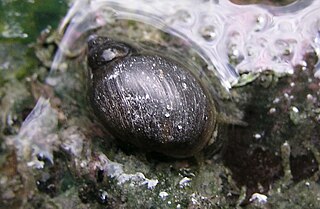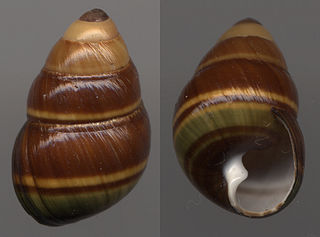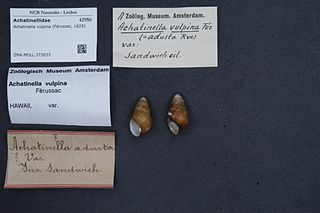
Bryce Canyon National Park is an American national park located in southwestern Utah. The major feature of the park is Bryce Canyon, which despite its name, is not a canyon, but a collection of giant natural amphitheaters along the eastern side of the Paunsaugunt Plateau. Bryce is distinctive due to geological structures called hoodoos, formed by frost weathering and stream erosion of the river and lake bed sedimentary rocks. The red, orange, and white colors of the rocks provide spectacular views for park visitors. Bryce Canyon National Park is much smaller, and sits at a much higher elevation than nearby Zion National Park. The rim at Bryce varies from 8,000 to 9,000 feet.

Kayenta, Arizona is a settlement in the Navajo reservation.

The Kanab ambersnail, scientific name Oxyloma haydeni kanabense or Oxyloma kanabense, is a critically endangered subspecies or species of small, air-breathing land snail, a terrestrial pulmonate gastropod mollusc in the family Succineidae, the amber snails. The common name of the amber snails is based on the shell, which is translucent and when empty usually resembles the color of amber.

Physella is a genus of small, left-handed or sinistral, air-breathing freshwater snails, aquatic pulmonate gastropod mollusks in the family Physidae.

Physella acuta is a species of small, left-handed or sinistral, air-breathing freshwater snail, an aquatic gastropod mollusk in the family Physidae. Common names include European physa, tadpole snail, bladder snail, and acute bladder snail. In addition, Physa acuta, Physa heterostropha and Physa integra are synonyms of Physella acuta.

The Banff Springs snail is a species of small air-breathing freshwater snail in the family Physidae.

Achatinella abbreviata, an Oʻahu tree snail, is an extinct species of colorful tropical tree-living air-breathing land snail, an arboreal pulmonate gastropod mollusk in the genus Achatinella.

Achatinella vulpina is a species of air-breathing land snail, a terrestrial pulmonate gastropod mollusk in the family Achatinellidae. This species is endemic to Hawaii.
The Fish Lake physa, scientific name Physella microstriata, was a species of air-breathing freshwater snail, an aquatic gastropod mollusk in the family Physidae.
The Snake River physa snail, scientific name Physella natricina, is a species of freshwater snail, an aquatic gastropod mollusk in the family Physidae. This species is endemic to Idaho in the United States.
The cave physa is a species of small, air-breathing, freshwater snail, an aquatic pulmonate gastropod mollusk in the family Physidae. It lives only in caves.
The Utah physa, scientific name Physella utahensis, is a species of freshwater snail, an aquatic gastropod mollusk in the family Physidae.

Zion National Park is an American national park located in southwestern Utah near the town of Springdale. A prominent feature of the 229-square-mile (590 km2) park is Zion Canyon, which is 15 miles (24 km) long and up to 2,640 ft (800 m) deep. The canyon walls are reddish and tan-colored Navajo Sandstone eroded by the North Fork of the Virgin River. The lowest point in the park is 3,666 ft (1,117 m) at Coalpits Wash and the highest peak is 8,726 ft (2,660 m) at Horse Ranch Mountain. Located at the junction of the Colorado Plateau, Great Basin, and Mojave Desert regions, the park has a unique geography and a variety of life zones that allow for unusual plant and animal diversity. Numerous plant species as well as 289 species of birds, 75 mammals, and 32 reptiles inhabit the park's four life zones: desert, riparian, woodland, and coniferous forest. Zion National Park includes mountains, canyons, buttes, mesas, monoliths, rivers, slot canyons, and natural arches.

Astragalus zionis is a species of legume known by the common name Zion milkvetch. It is one of the earliest flowers to bloom in Zion canyon.
Eriogonum zionis, common name Zion wild buckwheat or Point Sublime wild buckwheat, is a plant species native to the southwestern United States, the states of Utah and Arizona. It grows on sandy or gravelly soil at elevations of 1300–2300 m.
Ericameria zionis, the subalpine goldenbush or cedar breaks goldenbush, is a rare North American species of flowering plants in the daisy family. It has been found only at high elevations in the mountains in the southern part of the state of Utah in the western United States. Some of the populations lie inside Cedar Breaks National Monument and Bryce Canyon National Park.
Oliver, G. V. and Bosworth, W. R. III. (1999). Rare, Imperiled, and Recently Extinct or Extirpated Mollusks of Utah: A Literature Review. Utah Division of Wildlife Resources. Publication Number 99-29.









